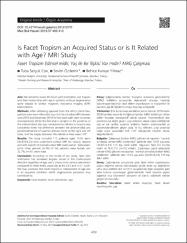Is Facet Tropism an Acquired Status or is It Related with Age? MRI Study
Özet
Aim: We aimed to reveal the facet joint orientation and tropism and their relationship with age in patients without degenerative spine disease in lumbar magnetic resonance imaging (MRI) examinations.
Methods: After obtaining approval from the ethics committee, patients who were referred to our clinic for a lumbar MRI between June 2018 and December 2018 for low back pain were reviewed retrospectively. When the line that is tangent to the posterior of the intervertebral disc was considered as reference, tropism was considered when the difference between the anteromedial and posterolateral line of superior articular facet on the right and left sides, and the angles between this reference lines were >10 degrees.
Results: The study included 113 patients aged 15-55 years (30.87 +/- 9.23) who underwent lumbar MRI for various reasons and with reports of normal lumbar MRI examination. Sixty-seven-point three percent (n=76) of the patients were female and 32.7% (n=37) were male.
Conclusion: According to the results of our study, facet joint orientation has increased angular values in the craniocaudal direction regardless of age, and it shows more coronal orientation compared to other levels, especially at the L4-5 and L5-S1 levels. We may conclude that facet tropism is independent of age and is an acquired condition which degenerative processes may contribute to.
Cilt
57Sayı
4Bağlantı
https://hdl.handle.net/11363/1590Koleksiyonlar
Aşağıdaki lisans dosyası bu öğe ile ilişkilidir:


















